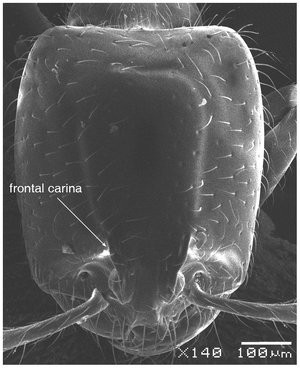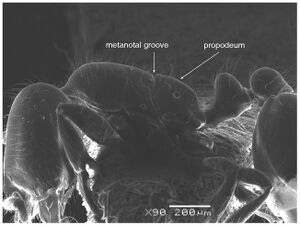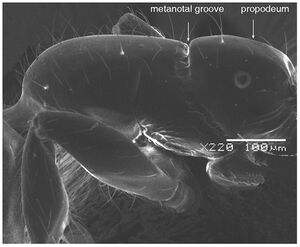Solenopsis elhawagryi
| Solenopsis elhawagryi | |
|---|---|

| |
| Scientific classification | |
| Kingdom: | Animalia |
| Phylum: | Arthropoda |
| Class: | Insecta |
| Order: | Hymenoptera |
| Family: | Formicidae |
| Subfamily: | Myrmicinae |
| Tribe: | Solenopsidini |
| Genus: | Solenopsis |
| Species: | S. elhawagryi |
| Binomial name | |
| Solenopsis elhawagryi Sharaf & Aldawood, 2012 | |
This species is only known from the type material. The ants were collected from a nest found under a rock in a forest.
Identification
Sharaf & Aldawood (2012) - Major workers can be easily separated from other Arabian Solenopsis by the color, head partially brownish yellow with the area in front of eyes yellowish and few scattered yellowish spots; posterior margin of first gastral tergite brownish. In addition, S. elhawagryi is similar to Solenopsis omana, both having the postpetiole with anteroventral projection, but the former species can be readily recognized from the later by the number of ommatidia of eyes which is four-five whereas in omana, eyes have seven ommatidia.
Affinities. Solenopsis elhawagryi appears closest to Solenopsis omana from Oman and UAE and Solenopsis dentata from Israel. All three species share the following characters: anterior clypeal margin with a central pair of stout projecting teeth and a lateral pair of short, broad basal blunt teeth; head longer than broad; petiole node high and rounded in profile, peduncle with a small ventral tooth, node from above distinctly broader than long; postpetiole in profile with a characteristic tooth-like anteroventral flange, with some projecting setae.
Solenopsis elhawagryi can be easily distinguished from S. dentata by the following characters: the postpetiolar tooth-like anteroventral flange is simple but distinct, whereas in dentata it is more acute, longer and clearly curved, and very characteristic; the eyes have four-five ommatidia while dentate has 7 ommatidia; the propodeal outline is a continuous curve in lateral view, whereas in dentata the propodeal dorsum meeting the declicity in an obtuse angle; elhawagryi has a characteristic V-shaped, narrow and acute metanotal groove, while the metanotal groove in dentata is less acute. In addition, elhawagryi has less abundant body pilosity while dentata has more abundant pilosity. Moreover, elhawagryi has a lower scape index, SI 60–80 against SI 81–89; the cephalic index is slightly lower, CI 76–88 against CI 82–89.
Comparing the queen of elhawagryi and dentata, both are similar in color (dark brown or blackish brown) and body measurements, but consistent differences occur. The eyes of elhawagryi are distinctly larger (about 0.336HW), with more than 25 ommatidia in the longest row, the dentata eyes are about 0.256HW, with 18 ommatidia in the longest row; elhawagryi has a lower cephalic index, CI 87 versus CI 93–95, and a slightly higher scape index SI 72 versus SI 67–69.
Comparing elhawagryi with omana, the major worker eyes have four-five ommatidia, compared with seven ommatidia; elhawagryi has the head in profile appearing thick with a flat dorsal surface, and a distinctly convex ventral surface, while in omana the head in profile appears narrow with a flat ventral surface; the cephalic index tends to be larger, CI 76–88 versus CI 79–81.
Keys including this Species
Distribution
Latitudinal Distribution Pattern
Latitudinal Range: 19.91306° to 19.91306°.
| North Temperate |
North Subtropical |
Tropical | South Subtropical |
South Temperate |
- Source: AntMaps
Distribution based on Regional Taxon Lists
Afrotropical Region: Saudi Arabia (type locality).
Distribution based on AntMaps
Distribution based on AntWeb specimens
Check data from AntWeb
Countries Occupied
| Number of countries occupied by this species based on AntWiki Regional Taxon Lists. In general, fewer countries occupied indicates a narrower range, while more countries indicates a more widespread species. |

|
Estimated Abundance
| Relative abundance based on number of AntMaps records per species (this species within the purple bar). Fewer records (to the left) indicates a less abundant/encountered species while more records (to the right) indicates more abundant/encountered species. |

|
Biology
Sharaf & Aldawood (2012) - The type locality is a forest called Elqamh Park, Beljorashi Governorate, Al Baha Province, Kingdom of Saudi Arabia, with many water pools, and soil has significant degree of humidity after heavy rainy season. The area has much native vegetation including: Acacia origena A. Hunde, Acacia negrri Pichi-Sermoli, Solanum sp., and Juniperus procera Hochst. Ex Endle. The type specimen was taken from a nest under a stone on loose soil next to a large and old Acacia tree, the nest contained tens of major and minor workers, and two alate queens. No additional nests were found despite extensive surveys in the area. In addition, we were unable to collect foraging workers near the nest. Several other ant species were found in the same habitat including: Crematogaster chiarinii (as Crematogaster affabilis), Monomorium mayri Forel, Monomorium salomonis, M. monomorium group, Tetramorium sericeiventre, and Lepisiota obtusa.
Castes
Worker
Images from AntWeb
   
| |
| Paratype of Solenopsis elhawagryi. Worker. Specimen code casent0217365. Photographer Erin Prado, uploaded by California Academy of Sciences. | Owned by CAS, San Francisco, CA, USA. |
   
| |
| Paratype of Solenopsis elhawagryi. Worker. Specimen code casent0217366. Photographer Erin Prado, uploaded by California Academy of Sciences. | Owned by CAS, San Francisco, CA, USA. |
         
| |
| . | |
 X-ray micro-CT scan 3D model of Solenopsis elhawagryi (worker) prepared by the Economo lab at OIST.
X-ray micro-CT scan 3D model of Solenopsis elhawagryi (worker) prepared by the Economo lab at OIST.
Rarely collected, likely subterranean species from the Arabian Peninsula. See on Sketchfab. See list of 3D images.
Queen
Images from AntWeb
    
| |
| Paratype of Solenopsis elhawagryi. Queen (alate/dealate). Specimen code casent0217361. Photographer Erin Prado, uploaded by California Academy of Sciences. | Owned by KSMA. |
Nomenclature
The following information is derived from Barry Bolton's Online Catalogue of the Ants of the World.
- elhawagryi. Solenopsis elhawagryi Sharaf & Aldawood, 2012: 4, figs. 1-20 (s.w.q.) SAUDI ARABIA.
- Type-material: holotype worker, 20 paratype workers.
- Type-locality: holotype Saudi Arabia: Al Baha Prov., Beljorashi Governorate, Elqamh Park,19.91306°N, 41.90500°E,1931 m., 17.v.2010 (M.R. Sharaf); paratypes with same data.
- [Note: the authors add that 20 more paratype workers are preserved in alcohol in KSMA.]
- Type-depositories: KSMA (holotype); BMNH, CASC, KSMA, MHNG, NHMB, WMLC (paratypes).
- Distribution: Saudi Arabia.
Unless otherwise noted the text for the remainder of this section is reported from the publication that includes the original description.
Description
Worker
Major Worker - Holotype worker (Major). TL 2.37; HL 0.65; HW 0.52; SL 0.37; EL 0.05; PRW 0.30; ML 0.62; PL 0.17; PW 0.17; PPL 0.12; PPW 0.17; Indices: SI 71; CI 80. Paratype major workers. TL 1.87–2.62; HL 0.50–0.65; HW 0.40–0.50; SL 0.30–0.40; EL 0.05; PRW 0.25–0.32; ML 0.50–0.77; PL 0.15–0.22; PW 0.12–0.20; PPL 0.10–0.15; PPW 0.12–0.20; Indices: SI 60–80; CI 76–88 (12 measured).
Head clearly longer than broad with weakly convex sides and nearly straight or very feebly concave posterior margin; cephalic dorsum smooth and shining with abundant short pitted setae; eyes small and oval, with four-five ommatidia; anterior clypeal margin with a central pair of stout projecting teeth and a lateral pair of short, broad basal blunt teeth; mandibles smooth and shiny, armed with four teeth, apical tooth largest followed by two subequal teeth, more widely separated, basal tooth smallest; antennae with terminal funicular segment long and about 3 times longer than proceeding segment; frontal carina much reduced. Metanotal groove a V-shape, with a narrow, acute cleft; propodeum outline a continuous curve in lateral view; propodeal spiracle circular. Petiolar peduncle with a small ventral tooth, high node and rounded dorsum, in dorsal view and about twice as broad as long. Postpetiole profile high and slightly spherical, with a distinct anteroventral tooth-like process bearing few setae; dorsum with a weak, superficial alveolate pattern; pilosity of mesosoma, petiole, postpetiole and gaster relatively abundant and long. Coloration overall yellow; head partially brownish yellow with the area in front of eyes yellowish and few scattered yellowish spots; posterior margin of first gastral tergite brownish. Overall smooth and shining.
Minor worker Paratype small workers. TL 1.55–1.82; HL 0.42–0.47; HW 0.35–0.50; SL 0.22–0.30; EL 0.02; PRW 0.17–0.25; ML 0.42–0.50; PL 0.12–0.17; PW 0.12–0.15; PPL 0.10–0.12; PPW 0.12–0.15; Indices: SI 50–88; CI 74–111 (16 measured).
Most characters are as in the major workers but: head little longer than broad, with feebly convex sides; eyes proportionally smaller, with four ommatidia; central clypeal teeth widely separated, long, and acute; body pilosity shorter, especially on the head.
Queen
Paratype queen. TL 4.30; HL 0.75; HW 0.65; SL 0.47; EL 0.22; PRW 0.72; ML 1.40; PL 0.35; PW 0.27; PPL 0.25; PPW 0.30; Indices: SI 72; CI 87.
Head distinctly longer than broad with slightly convex sides and a feebly concave posterior margin; cephalic dorsum smooth and brilliant with abundant inwardly-directed setae, central setae much longer; the three ocelli large and whitish; eyes very large (about 0.33× HW) with more than 25 ommatidia in the longest row; anterior clypeal margin with a central pair of stout projecting teeth, and a lateral pair of short, broad basal blunt teeth; mandibles faintly longitudinally striated, armed with four teeth, the distal one being the largest, and the second and third being subequal and slightly far apart; basal tooth the smallest; antennal scape short, just surpassing the level of posterior margin of eyes; frontal carinae much reduced. Mesosoma robust with abundant, short, suberect setae. Petiolar dorsum narrow and convex in profile. Postpetiolar dorsum wide and convex. Petiole and postpetiole have abundant, long, backwardly-directed setae and petiole with a small distinct anteroventral toothlike process which bears few long setae; both smooth and shining, with imbricate sculpture on sides. Gaster long and robust. Color uniformly dark brown, funiculus, distal half of scape, legs and mandibles yellowish, basal half of scape brownish yellow, mesopleura light brownish.
Type Material
Type location. SAUDI ARABIA, Al Baha Province, Beljorashi Governorate, Elqamh Park, 19.91306uN, 41.90500uE, 1931 m.a.s.l. 17.v.2010 (M. R. Sharaf leg.); King Saud Museum of Arthropods (King Saud Museum of Arthropods), College of Food and Agriculture Sciences, King Saud University, Riyadh, Kingdom of Saudi Arabia.
Paratypes. 20 workers, same locality and data as holotype, 1 (Musee d'Histoire Naturelle Genève); 1 (Naturhistorisches Museum, Basel); 1 (California Academy of Sciences); 1 (World Museum, Liverpool); 1 (The Natural History Museum) and 15 (KSMA). In addition, 35 paratype specimens preserved in alcohol, 8 major workers and 27 minors (KSMA).
Etymology
This new species is named in the honor of Prof. Magdi El-Hawagry (Cairo University and Al Baha University).
References
- Sharaf, M.R. and Aldawood, A.S. 2012. Ants of the genus Solenopsis Westwood 1840 in the Arabian Peninsula with description of a new species, Solenopsis elhawagryi. PloS ONE. 7(11):21 pp. doi:10.1371/journal.pone.0049485
- Sharaf, M.R., Gotzek, D., Guénard, B., Fisher, B.L., Aldawood, A.S., Al Dhafer, H.M., Mohamed, A.A. 2020. Molecular phylogenetic analysis and morphological reassessments of thief ants identify a new potential case of biological invasions. Scientific Reports 10, 12040 (doi:10.1038/s41598-020-69029-4).
References based on Global Ant Biodiversity Informatics
- El-Hawagry M. S., M. W. Khalil, M. R. Sharaf, H. H. Fadl, and A. S. Aldawood. 2013. A preliminary study on the insect fauna of Al-Baha Province, Saudi Arabia, with descriptions of two new species. ZooKeys 274: 188. doi:10.3897/zookeys.274.4529
- Sharaf M. R., and A. S. Aldawood. 2012. Ants of the genus Solenopsis Westwood 1840 (Hymenoptera: Formicidae) in the Arabian Peninsula with description of a new species, Solenopsis elhawagryi. PLoS ONE 7(11): e49485. doi:10.1371/journal.pone.0049485


